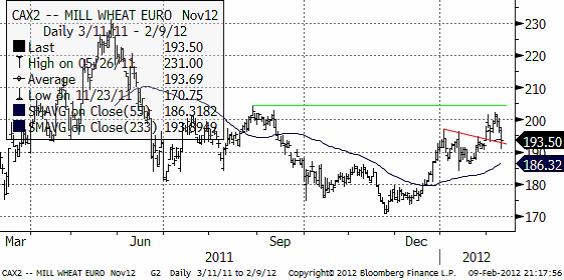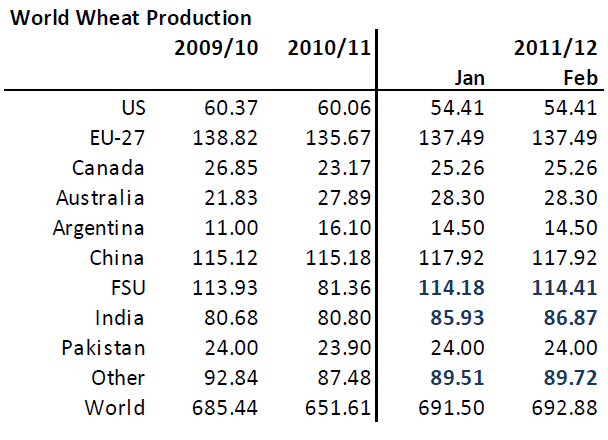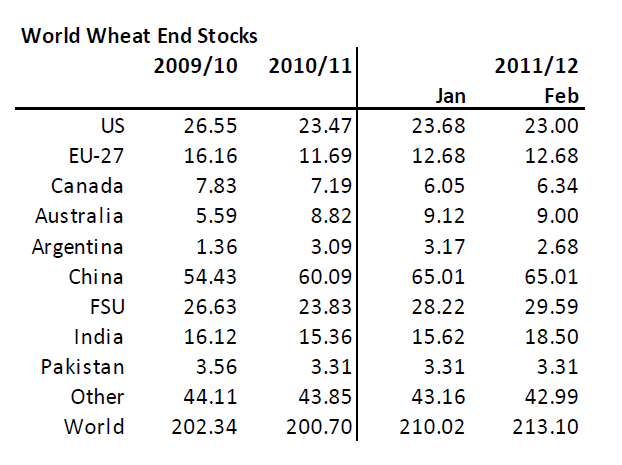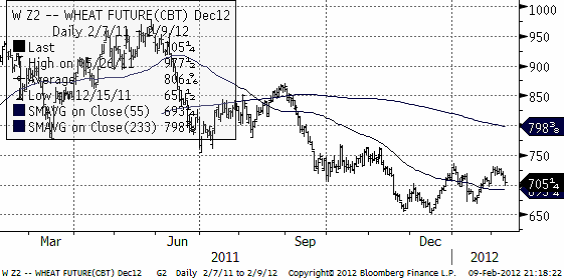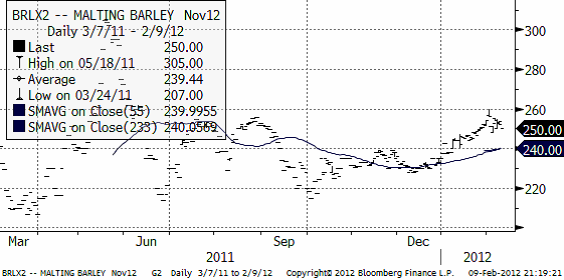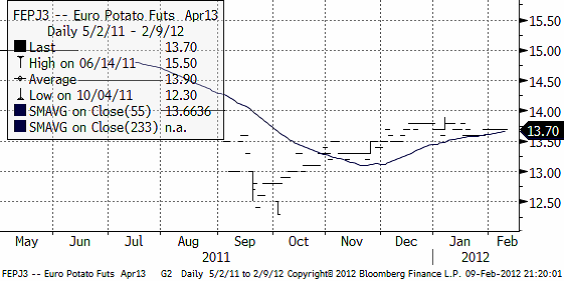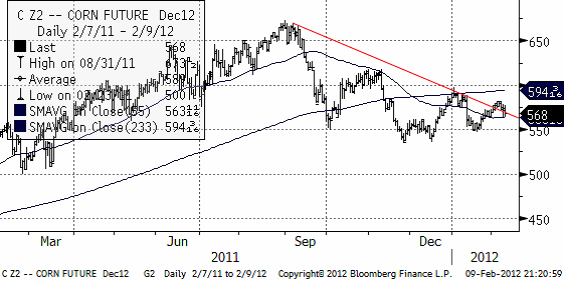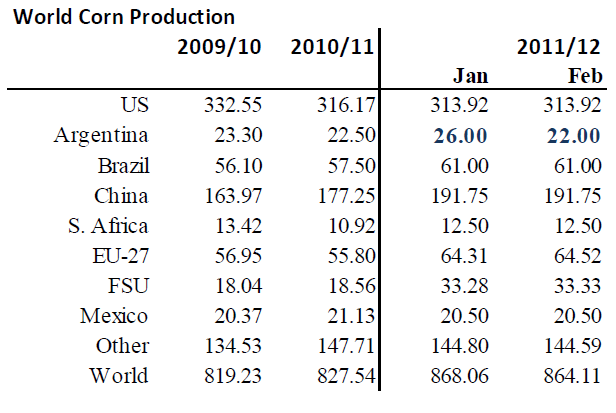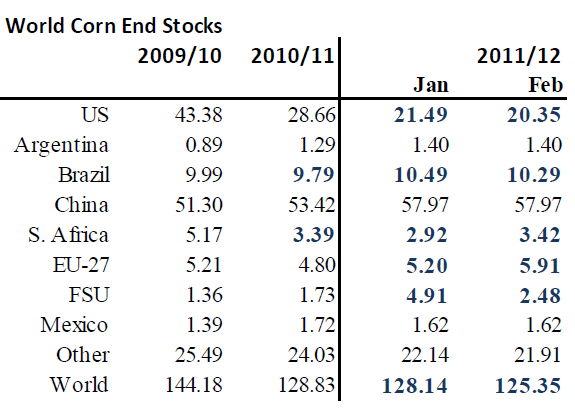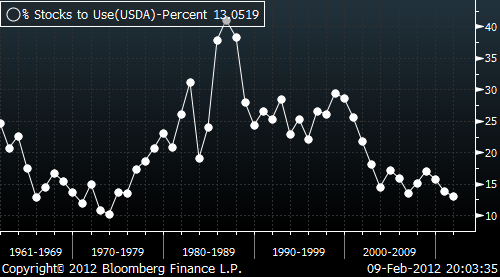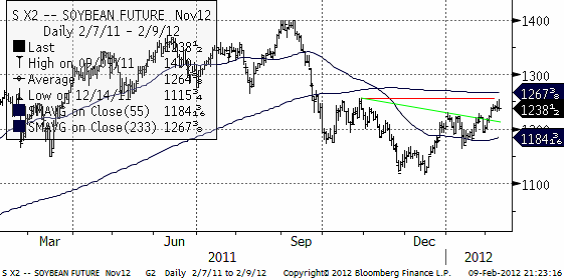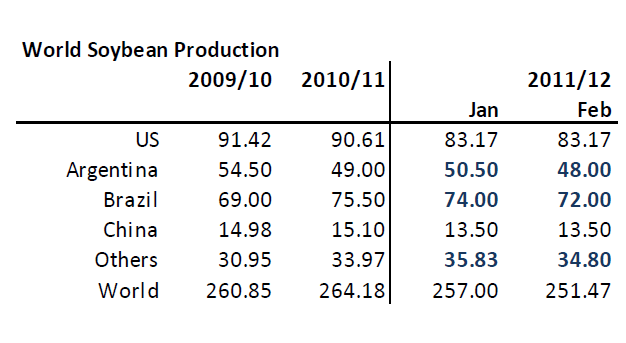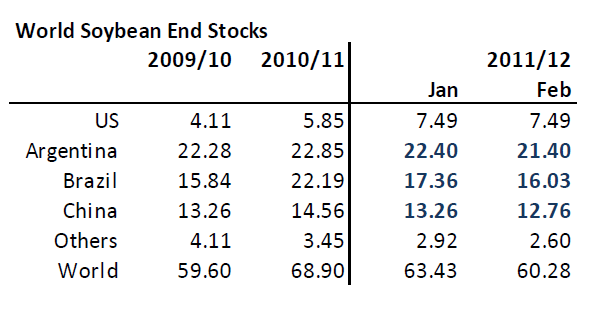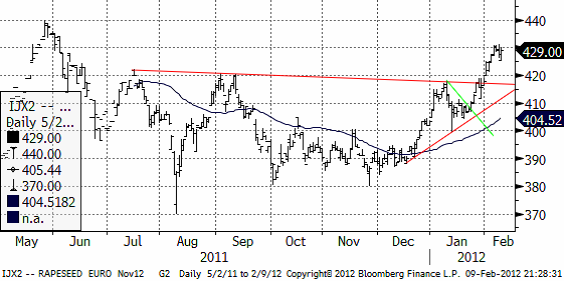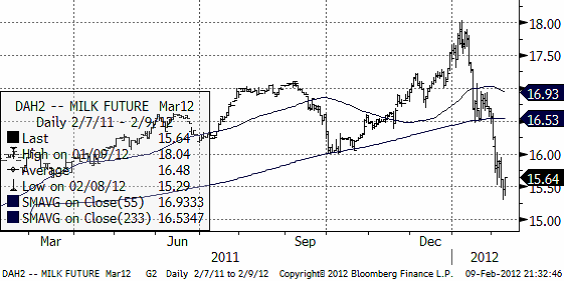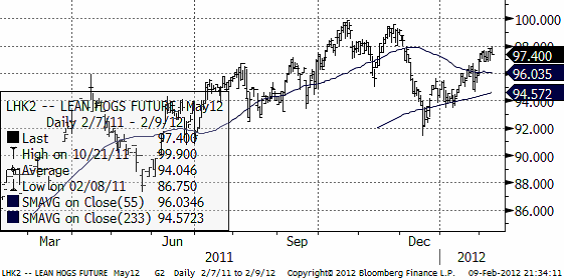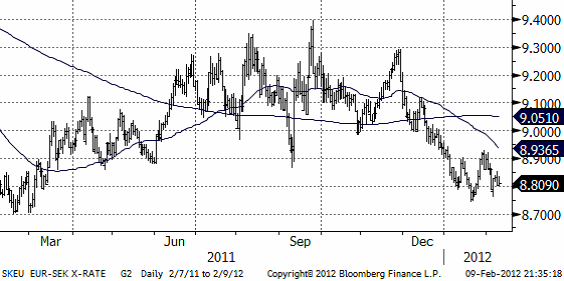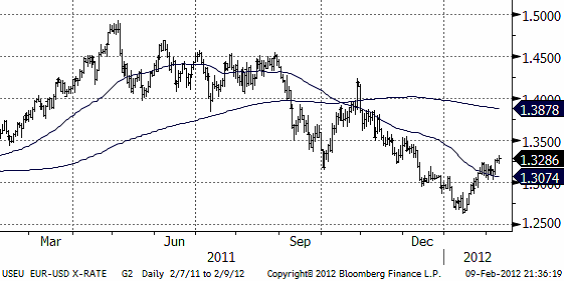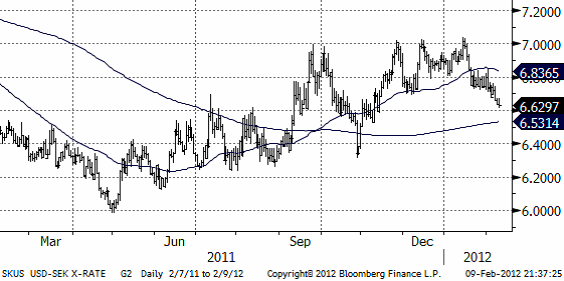Analys
SEB – Jordbruksprodukter, vecka 6 2012
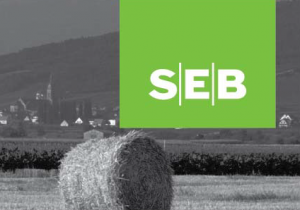 Vi har hållit på skrivandet och utskicket av det här veckobrevet för att få med intrycken av WASDE-rapporten som släpptes av USDA klockan 14:30 igår torsdag. Rapporten, vars siffror nog förefaller vara övermåttan försiktigt justerade med anledning av torkan i Argentina, togs emot med något av en axelryckning av marknaden, men med tydliga prisnedgångar för alla grödor, mest för vete, där utgående lager justerades upp.
Vi har hållit på skrivandet och utskicket av det här veckobrevet för att få med intrycken av WASDE-rapporten som släpptes av USDA klockan 14:30 igår torsdag. Rapporten, vars siffror nog förefaller vara övermåttan försiktigt justerade med anledning av torkan i Argentina, togs emot med något av en axelryckning av marknaden, men med tydliga prisnedgångar för alla grödor, mest för vete, där utgående lager justerades upp.
NOAA rapporterar i sin senaste synopsis att La Niña torde övergå till ”neutrala” ENSO-förållanden under perioden mars till maj 2012. Detta skulle betyda att hotet mot torka för norra halvklotets skörd kraftigt har minskat. Detta är klart negativ information för marknaderna för majs, vete, sojabönor och raps.
Vete
Terminspriset på Matif-vete (november) föll kraftigt till 193.50 euro / ton efter WASDE-rapporten
Marknadens oro över ett ryskt exportförbud har kvarstått under veckan och de blandade budskap som kommit från Rysslands regering har orsakat en viss förvirring.
Rysslands premiärminister Viktor Zubkov sa att med tanke på att spannmålsskörden reviderats till 93,9 miljoner ton så har prognosen för spannmålsexporten 2011/12 höjts till 27 miljoner ton och att det därmed inte skulle finnas något behov av att införa restriktioner, vilket hade diskuterats till följd av den höga exporttakt som har rått.
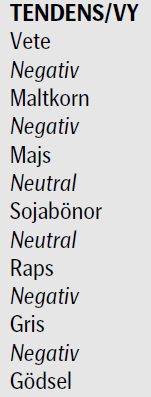 Det uttalandet kom strax efter att regeringskällor sa att Zubkov inte skulle meddela något beslut under fredagen och det i sin tur kom efter att vice premiärministern inte kunde uttala sig i frågan under torsdagen som tidigare angivits. De dubbla budskapen började dock redan på tisdagen då den biträdande jordbruksministern sade att ett beslut om export restriktioner skulle tas i mitten på februari, för att sedan skifta till att Zubkov skulle meddela beslutet under torsdagen.
Det uttalandet kom strax efter att regeringskällor sa att Zubkov inte skulle meddela något beslut under fredagen och det i sin tur kom efter att vice premiärministern inte kunde uttala sig i frågan under torsdagen som tidigare angivits. De dubbla budskapen började dock redan på tisdagen då den biträdande jordbruksministern sade att ett beslut om export restriktioner skulle tas i mitten på februari, för att sedan skifta till att Zubkov skulle meddela beslutet under torsdagen.
Den snabba exporttakten av Rysslands spannmål har varit regerings främsta orosmoln genom att den skulle kunna driva upp de inhemska priserna kraftigt med en ökad matinflation och högre kostnader för animalie producenter som följd. Men eftersom spannmålen för export från gårdar och silos i närheten av hamnarna vid Svarta havet börjar sina så tvingas handlarna att se sig om efter spannmål längre in i landet vilket innebär långväga transporter på landets järnvägsnät som också bidrar till högre kostnader.
Det kalla vädret har också varit en bidragande faktor till oro. I Ryssland verkar dock snötäcket skydda de flesta grödor medan det kalla vädret i Svarta havsområdet kan komma att orsaka skador på framförallt korn och raps. Trots det kalla vädret i Europa så är påverkan av rapsgrödorna i Tyskland och Frankrike dock mindre oroande. I Ukraina är problemen desto större med effekten av kylan på de grödor som redan har drabbats av en oerhört torr höst och där vissa delar av landet har fått mycket snö, på sina ställen upp till 50 cm, medan andra delar av landet helt saknar snötäcke grödorna därmed exponeras för den extrema kylan. Med en mild höst och en ”varm vinter” kan det hända att grödorna blir något mindre vinterhärdiga än förväntat men det verkar dock som att de flesta europeiska länder har fått ett skyddande snötäcke mot kylan, även om det på vissa ställen vore önskvärt med ett större snödjup. Ännu är det dock för tidigt att sia om eventuella konsekvenser. Nedan ser vi WASDE-rapportens estimat för global veteproduktion.
Indien, Kazakstan och Marocko har justerat upp sina produktionsestimat, vilket slår igenom i en högre global produktion.
På konsumtionssidan är det främst Indien, som beräknas konsumera 1.6 mt mindre än i januari. Konsumtionen i EU och resten av världen är oförändrad, trots ett mycket högre pris än förra månaden. Men summa summarum – vi har trots allt ett högre utgående lager av vete än förra månaden.
Vi vet sedan tidigare att USDA har en tendens att fortsätta med justeringar ”åt samma håll”. Vi kan alltså förvänta oss högre uppjusteringarna av utgående lager att fortsätta, månad för månad, i WASDE-rapporterna och detta bör understödja en trend av sjunkande priser på vete. Nedan ser vi kursdiagrammet på decemberkontraktet på CBOT.
Maltkorn
Maltkornsmarknaden har behållit sin styrka relativt andra spannmål med novemberleverans på Matif på 250 euro per ton.
Potatis
Nedan ser vi kursdiagrammet på europeisk potatis, som handlas på Eurex; terminen avser leverans april 2013.
Majs
Majspriset föll något lite när börsen öppnade efter USDA-rapporten, som vi ser i kursdiagrammet för decemberkontraktet nedan:
WASDE-rapporten visade dock på lägre produktion och lägre – rekordlåga utgående lager.
USDA justerade ner skörden i Argentina i spåren av torkan, från 26 mt till 22 mt. 22 mt ligger på den högsta nivån som vi sett inhemska Argentinska prognosmakare förutspå, som ligger i intervallet 18 – 22 mt. Produktionen skulle alltså ha kunnat minska med 8 mt istället för de 4 mt som USDA förutspår nu i sin februarirapport. USDA gör ingen justering för Brasiliens skörd, vilket stämmer någorlunda bra med vädret där.
USA:s utgående lager som anges i WASDE:n ligger på den lägsta nivån sedan 1975/76 och utgående lager på global basis i förhållande till konsumtion ligger på 1973 års nivå, som vi ser i nedanstående diagram.
Med ett förmodligen större bortfall från produktion och export från Argentina, måste detta kompenseras med lägre lager i USA. Det kan alltså bli ett riktigt lågt utgående lager i USA – och på global basis.
Å andra sidan väntas amerikanska bönder välja att så majs på bekostnad av sojabönor i vår. Ett högre pris på majs skulle öka denna tendens.
Sojabönor
Priset på sojabönor föll efter WASDE-rapporten i linje med de andra grödorna. Tekniskt är situationen intressant. Det finns de, bland annat SEB:s tekniska analytiker, som pekar på att det sedan september bildats en omvänd ”head-and-shoulders” formation, där ”nacklinjen” (grön linje) bröts i månadsskiftet januari – februari. Den skulle signalera en förestående potentiell prisuppgång till 1400 cent / bushel. Prisuppgången har dock stoppats av motståndet som utgörs av toppen som noterades i slutet av oktober. Skulle vi få en uppgång över 1267 får vi anse att vi har en teknisk köpsignal.
Nedan ser vi USDA:s produktionsestimat från WASDE-rapporten igår.
Argentinas och Brasiliens skörd sänks med 2.5 mt respektive 2 mt i spåren av torkan. Bland ”Others” hittar vi Paraguay och Uruguay och de justeras ner 1 mt också.
Utgående lager sänks 3 mt. Argentinas skörd ligger i det övre intervallet av inhemska skördeestimat. Det känns som om man tagit i lite i underkant i justeringen och det är vanligt att USDA gör så. Vi kan alltså vänta oss att det ligger ytterligare en nedjustering sparad till nästa månad.
Vi är negativa ur tekniskt perspektiv de närmaste tre månaderna.
Raps
Priset på raps har gått starkt och hejdats på 430, uppenbarligen ett motstånd. Prisuppgången dit är ungefär lika lång från 410 – botten på rekylen i uppgången från 390. Det är 20 euro i båda rusningarna uppåt. Det är vanligt att man ser den typen av rörelser, där det är lika långt från ”halvvägskonsolideringen” uppåt som nedåt. Detta skulle indikera att den kortsiktiga uppgången är över. Vid 440 finns ett större motstånd, där priset vände ner i maj-juni förra året. Detta är alltså ett högt pris i ett historiskt perspektiv och säljvärt, tror vi.
Mjölk
Nedan ser vi priset på marskontraktet på flytande mjölk (kontakt avräknat mot USDA:s prisindex). Priset har som vi ser fallit kraftigt i februari. Marknaden är ”översåld” och ”borde” få en kortsiktig rekyl uppåt den närmaste veckan.
Gris
Priset på lean hogs har segat sig uppåt och befinner sig nu återigen i sälj-området. Nedan ser vi terminspriset för leverans i maj.
Valutor
EURSEK som fanns stöd på 8.80 kr och steg till 8.90 har vänt ner igen och ska sannolikt testa 8.80 igen.
EURUSD har vänt upp och har precis lämnat en konsolidering – kanske halvvägs på väg upp mot 1.35 dollar.
USDSEK har fallit av och tycks vara på väg nedåt.
[box]SEB Veckobrev Jordbruksprodukter är producerat av SEB Merchant Banking och publiceras i samarbete och med tillstånd på Råvarumarknaden.se[/box]
Disclaimer
The information in this document has been compiled by SEB Merchant Banking, a division within Skandinaviska Enskilda Banken AB (publ) (“SEB”).
Opinions contained in this report represent the bank’s present opinion only and are subject to change without notice. All information contained in this report has been compiled in good faith from sources believed to be reliable. However, no representation or warranty, expressed or implied, is made with respect to the completeness or accuracy of its contents and the information is not to be relied upon as authoritative. Anyone considering taking actions based upon the content of this document is urged to base his or her investment decisions upon such investigations as he or she deems necessary. This document is being provided as information only, and no specific actions are being solicited as a result of it; to the extent permitted by law, no liability whatsoever is accepted for any direct or consequential loss arising from use of this document or its contents.
About SEB
SEB is a public company incorporated in Stockholm, Sweden, with limited liability. It is a participant at major Nordic and other European Regulated Markets and Multilateral Trading Facilities (as well as some non-European equivalent markets) for trading in financial instruments, such as markets operated by NASDAQ OMX, NYSE Euronext, London Stock Exchange, Deutsche Börse, Swiss Exchanges, Turquoise and Chi-X. SEB is authorized and regulated by Finansinspektionen in Sweden; it is authorized and subject to limited regulation by the Financial Services Authority for the conduct of designated investment business in the UK, and is subject to the provisions of relevant regulators in all other jurisdictions where SEB conducts operations. SEB Merchant Banking. All rights reserved.
Analys
More weakness and lower price levels ahead, but the world won’t drown in oil in 2026

Some rebound but not much. Brent crude rebounded 1.5% yesterday to $65.47/b. This morning it is inching 0.2% up to $65.6/b. The lowest close last week was on Thursday at $64.11/b.

The curve structure is almost as week as it was before the weekend. The rebound we now have gotten post the message from OPEC+ over the weekend is to a large degree a rebound along the curve rather than much strengthening at the front-end of the curve. That part of the curve structure is almost as weak as it was last Thursday.
We are still on a weakening path. The message from OPEC+ over the weekend was we are still on a weakening path with rising supply from the group. It is just not as rapidly weakening as was feared ahead of the weekend when a quota hike of 500 kb/d/mth for November was discussed.
The Brent curve is on its way to full contango with Brent dipping into the $50ies/b. Thus the ongoing weakening we have had in the crude curve since the start of the year, and especially since early June, will continue until the Brent crude oil forward curve is in full contango along with visibly rising US and OECD oil inventories. The front-month Brent contract will then flip down towards the $60/b-line and below into the $50ies/b.
At what point will OPEC+ turn to cuts? The big question then becomes: When will OPEC+ turn around to make some cuts? At what (price) point will they choose to stabilize the market? Because for sure they will. Higher oil inventories, some more shedding of drilling rigs in US shale and Brent into the 50ies somewhere is probably where the group will step in.
There is nothing we have seen from the group so far which indicates that they will close their eyes, let the world drown in oil and the oil price crash to $40/b or below.
The message from OPEC+ is also about balance and stability. The world won’t drown in oil in 2026. The message from the group as far as we manage to interpret it is twofold: 1) Taking back market share which requires a lower price for non-OPEC+ to back off a bit, and 2) Oil market stability and balance. It is not just about 1. Thus fretting about how we are all going to drown in oil in 2026 is totally off the mark by just focusing on point 1.
When to buy cal 2026? Before Christmas when Brent hits $55/b and before OPEC+ holds its last meeting of the year which is likely to be in early December.
Brent crude oil prices have rebounded a bit along the forward curve. Not much strengthening in the structure of the curve. The front-end backwardation is not much stronger today than on its weakest level so far this year which was on Thursday last week.

The front-end backwardation fell to its weakest level so far this year on Thursday last week. A slight pickup yesterday and today, but still very close to the weakest year to date. More oil from OPEC+ in the coming months and softer demand and rising inventories. We are heading for yet softer levels.

Analys
A sharp weakening at the core of the oil market: The Dubai curve

Down to the lowest since early May. Brent crude has fallen sharply the latest four days. It closed at USD 64.11/b yesterday which is the lowest since early May. It is staging a 1.3% rebound this morning along with gains in both equities and industrial metals with an added touch of support from a softer USD on top.

What stands out the most to us this week is the collapse in the Dubai one to three months time-spread.
Dubai is medium sour crude. OPEC+ is in general medium sour crude production. Asian refineries are predominantly designed to process medium sour crude. So Dubai is the real measure of the balance between OPEC+ holding back or not versus Asian oil demand for consumption and stock building.
A sharp weakening of the front-end of the Dubai curve. The front-end of the Dubai crude curve has been holding out very solidly throughout this summer while the front-end of the Brent and WTI curves have been steadily softening. But the strength in the Dubai curve in our view was carrying the crude oil market in general. A source of strength in the crude oil market. The core of the strength.
The now finally sharp decline of the front-end of the Dubai crude curve is thus a strong shift. Weakness in the Dubai crude marker is weakness in the core of the oil market. The core which has helped to hold the oil market elevated.
Facts supports the weakening. Add in facts of Iraq lifting production from Kurdistan through Turkey. Saudi Arabia lifting production to 10 mb/d in September (normal production level) and lifting exports as well as domestic demand for oil for power for air con is fading along with summer heat. Add also in counter seasonal rise in US crude and product stocks last week. US oil stocks usually decline by 1.3 mb/week this time of year. Last week they instead rose 6.4 mb/week (+7.2 mb if including SPR). Total US commercial oil stocks are now only 2.1 mb below the 2015-19 seasonal average. US oil stocks normally decline from now to Christmas. If they instead continue to rise, then it will be strongly counter seasonal rise and will create a very strong bearish pressure on oil prices.
Will OPEC+ lift its voluntary quotas by zero, 137 kb/d, 500 kb/d or 1.5 mb/d? On Sunday of course OPEC+ will decide on how much to unwind of the remaining 1.5 mb/d of voluntary quotas for November. Will it be 137 kb/d yet again as for October? Will it be 500 kb/d as was talked about earlier this week? Or will it be a full unwind in one go of 1.5 mb/d? We think most likely now it will be at least 500 kb/d and possibly a full unwind. We discussed this in a not earlier this week: ”500 kb/d of voluntary quotas in October. But a full unwind of 1.5 mb/d”
The strength in the front-end of the Dubai curve held out through summer while Brent and WTI curve structures weakened steadily. That core strength helped to keep flat crude oil prices elevated close to the 70-line. Now also the Dubai curve has given in.

Brent crude oil forward curves

Total US commercial stocks now close to normal. Counter seasonal rise last week. Rest of year?

Total US crude and product stocks on a steady trend higher.

Analys
OPEC+ will likely unwind 500 kb/d of voluntary quotas in October. But a full unwind of 1.5 mb/d in one go could be in the cards

Down to mid-60ies as Iraq lifts production while Saudi may be tired of voluntary cut frugality. The Brent December contract dropped 1.6% yesterday to USD 66.03/b. This morning it is down another 0.3% to USD 65.8/b. The drop in the price came on the back of the combined news that Iraq has resumed 190 kb/d of production in Kurdistan with exports through Turkey while OPEC+ delegates send signals that the group will unwind the remaining 1.65 mb/d (less the 137 kb/d in October) of voluntary cuts at a pace of 500 kb/d per month pace.

Signals of accelerated unwind and Iraqi increase may be connected. Russia, Kazakhstan and Iraq were main offenders versus the voluntary quotas they had agreed to follow. Russia had a production ’debt’ (cumulative overproduction versus quota) of close to 90 mb in March this year while Kazakhstan had a ’debt’ of about 60 mb and the same for Iraq. This apparently made Saudi Arabia angry this spring. Why should Saudi Arabia hold back if the other voluntary cutters were just freeriding? Thus the sudden rapid unwinding of voluntary cuts. That is at least one angle of explanations for the accelerated unwinding.
If the offenders with production debts then refrained from lifting production as the voluntary cuts were rapidly unwinded, then they could ’pay back’ their ’debts’ as they would under-produce versus the new and steadily higher quotas.
Forget about Kazakhstan. Its production was just too far above the quotas with no hope that the country would hold back production due to cross-ownership of oil assets by international oil companies. But Russia and Iraq should be able to do it.
Iraqi cumulative overproduction versus quotas could reach 85-90 mb in October. Iraq has however steadily continued to overproduce by 3-5 mb per month. In July its new and gradually higher quota came close to equal with a cumulative overproduction of only 0.6 mb that month. In August again however its production had an overshoot of 100 kb/d or 3.1 mb for the month. Its cumulative production debt had then risen to close to 80 mb. We don’t know for September yet. But looking at October we now know that its production will likely average close to 4.5 mb/d due to the revival of 190 kb/d of production in Kurdistan. Its quota however will only be 4.24 mb/d. Its overproduction in October will thus likely be around 250 kb/d above its quota with its production debt rising another 7-8 mb to a total of close to 90 mb.
Again, why should Saudi Arabia be frugal while Iraq is freeriding. Better to get rid of the voluntary quotas as quickly as possible and then start all over with clean sheets.
Unwinding the remaining 1.513 mb/d in one go in October? If OPEC+ unwinds the remaining 1.513 mb/d of voluntary cuts in one big go in October, then Iraq’s quota will be around 4.4 mb/d for October versus its likely production of close to 4.5 mb/d for the coming month..
OPEC+ should thus unwind the remaining 1.513 mb/d (1.65 – 0.137 mb/d) in one go for October in order for the quota of Iraq to be able to keep track with Iraq’s actual production increase.
October 5 will show how it plays out. But a quota unwind of at least 500 kb/d for Oct seems likely. An overall increase of at least 500 kb/d in the voluntary quota for October looks likely. But it could be the whole 1.513 mb/d in one go. If the increase in the quota is ’only’ 500 kb/d then Iraqi cumulative production will still rise by 5.7 mb to a total of 85 mb in October.
Iraqi production debt versus quotas will likely rise by 5.7 mb in October if OPEC+ only lifts the overall quota by 500 kb/d in October. Here assuming historical production debt did not rise in September. That Iraq lifts its production by 190 kb/d in October to 4.47 mb/d (August level + 190 kb/d) and that OPEC+ unwinds 500 kb/d of the remining quotas in October when they decide on this on 5 October.

-

 Nyheter4 veckor sedan
Nyheter4 veckor sedanMahvie Minerals i en guldtrend
-

 Analys4 veckor sedan
Analys4 veckor sedanVolatile but going nowhere. Brent crude circles USD 66 as market weighs surplus vs risk
-

 Nyheter4 veckor sedan
Nyheter4 veckor sedanAktier i guldbolag laggar priset på guld
-

 Nyheter3 veckor sedan
Nyheter3 veckor sedanKinas elproduktion slog nytt rekord i augusti, vilket även kolkraft gjorde
-

 Nyheter3 veckor sedan
Nyheter3 veckor sedanTyskland har så höga elpriser att företag inte har råd att använda elektricitet
-

 Nyheter4 veckor sedan
Nyheter4 veckor sedanGuld når sin högsta nivå någonsin, nu även justerat för inflation
-

 Nyheter4 veckor sedan
Nyheter4 veckor sedanDet stigande guldpriset en utmaning för smyckesköpare
-

 Analys4 veckor sedan
Analys4 veckor sedanWaiting for the surplus while we worry about Israel and Qatar


